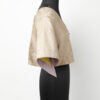With a cross-over front panel, secured with a fabric covered button and rouleau loop, she can be worn on her own over a high waisted skirt/trouser or even layered over a dress.
Although rich in fabric and design aesthetic, the Vinyāsa is feather-light, ideal for layering.
Our model is a UK size 8, measuring 1.63 meters in height
As timeless as the City itself, these silks are (in our opinion) the piѐce de resistance of all saree textiles!
Synonymous with intricate designs, eclectic motifs, rich embroidery, softness, ease of drape, luxurious textures and breath-taking opulence (we promise you the list goes on!), Banaras silk was introduced to India by the Mughal Empire (1000 to 300BC).
The confluence of Mughal and Hindu influence resulted in the creation of unique patterns, shades, designs and weaving techniques that can only be found in Varanasi.
This ancient ‘city of lights’ situated along the banks of the river Ganga, is home to some of the most talented artisans known as Karigars.
A Benarasi saree takes anywhere from 15 – 30 days to weave by hand. Based on the complexity of the design, this process could require up to 3 weavers working on a single piece.
The process begins with sketching of the designs onto graph paper by an artist, to create design boards. The final design is only created after a series of punch cards are made. Hundreds of perforated cards are required for a single design!
Threads, in colours across the colour spectrum, are then used to knit these cards on the loom.
Watch our video to view this traditional artform in action
















 100% pure Habotai Silk lining
100% pure Habotai Silk lining Contrasting Lining (Mustard Gold)
Contrasting Lining (Mustard Gold) Fabric covered button, rouleau loop
Fabric covered button, rouleau loop Made by hand
Made by hand Craft: Handloom weave
Craft: Handloom weave Origin: Varanasi
Origin: Varanasi Time on loom approx. 30 days of love, care & craft
Time on loom approx. 30 days of love, care & craft


